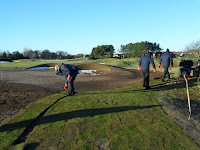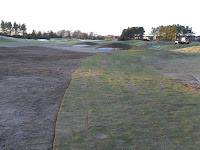Still snow on the course, here is a bit of history for bedtime reading!!
Part 1
Championship Course
Although golf somewhere on “Barry Links” goes back to the 15th century there is no record of a formal layout until the early 19th century when a 5-hole course starting near the Station Road railway crossing was known to be in existence. The holes followed the coast line with a 2nd green in the vicinity of the present 18th, the 3rd at the cup (now the 1st), the 4th in the valley (today’s 2nd) and a 5th farther south on the same line. Players at that time then played homeward to the same holes!

Sometime in the 1840’s the 5-hole course was developed initially to 7 by Allan Robertson, the world’s first golf professional, from St Andrews. The first 4 were played as previously, then a 5th near to the present 3rd, a 6th in the vicinity of today’s 16th and a 7th in the area of the present Burnside car-park. Robertson carried out further work in the 1850’s with the 1st starting near the present 1st tee, the cup, formerly the 3rd hole, followed by the valley (former 4th) and then Jockies’ Ditch (former 5th), a new green was introduced (approximately where the 4th is now ), turning northwards for the 5th which subsequently gained the title of the “grog” hole. The 6th was then played eastwards to a green closer to the “battery” than the present 16th which had the name of the “tickets” as notices were set up nearby warning of the penalties for allowing dogs on to Lord Dalhousie’s rabbit warrens to the south! This green had the best turf in Carnoustie in the late 1850’s and was occasionally used for bowling matches. The 7th was played as before (“Sma’ Burn”). Narrow clearances were made through thick gorse to reach the 8th (westwards) and 9th (eastwards) to a green just over the “Sma’ Burn” and adjacent to the 7th. These holes were known as the “whin” holes. The 10th and final hole was then played crossing the line of the 7th and the burn twice to a site near the present 18th green. The two original holes from Station Road were retained for some years as practice holes.
George Morris, Tom’s brother, carried out some changes in the early 1860’s as curator of The Links which involved placing the 1st tee opposite Ferrier Street; taking in new ground for a green a little north of the present 6th and temporarily increasing the number of holes to 12.
Old Tom Morris was called upon by the Dalhousie Golf Club in 1872 to recommend alterations to relieve congestion and extend the course to 18 holes by continuing his brother’s extension of the course west and north-west to the turf dyke (present 11th hole).
The first 18-hole course, opened in 1873, was very short with eleven holes under 300yds and 3 under 200!
The 9th and 10th were made much more demanding when in 1879 a new 9th green was formed on the far side of the dyke, some 200yds beyond it’s predecessor.

The card of the Morris Course was as follows
1. Battery 367 -----10. Return 273
2. Cup 261 -----11. Grog 348
3. Gulley 264 -----12. South Burn 224
4. Ditch 252 -----13. Pot 212
5. Bowling Green 308 -----14. Carrot 316
6. South 256 -----15. Mid Burn 144
7. Cross 248 -----16. Factory 198
8. Westward Ho! 233 -----17. North Burn 184
9. Dyke 202 ----18. Home 275
2391 yrds out 2174 yrds in
4565 yrds
Course improvements continued, led by Bob Simpson, and lasted some 2 years (1886-88). Bunker sizes were reduced and the 8th hole carried about 100yds westward. Additional ground, the site of today’s 6th, 7th and 8th holes had been made fit for play. The 1st tee in front of the Dalhousie Clubhouse was moved westwards to allow room for the local cricketers!
Bob Simpson’s revised course (1888) was as follows
1. Battery 284-----10. Dyke 240
2. Cup 225 -----11. Eastward Ho! 367
3. Valley 353 -----12. Cross 225
4. Ditch (Saucer) 293 -----13. Bowling Green 217
5. Target 380 -----14. Flagstaff 360
6. South 277 -----15. Burn (or Roller) 330
7. Westward Ho! 433 -----16. Factory 383
8. Short 260 -----17. Whin 260
9. Railway 457 -----18. Home 273
2962 yrds out 2655 yrds in
5617 yrds
Further changes took place until in 1898 the overall length of the course had been extended to 6082yds.
In the early years of the twentieth century further developments took place which included in 1908 the first inclusion of a “South America” hole, then the 7th. In 1905 the “Spectacles” was converted into double green which at that time involved the 10th (eastwards, and 13th westwards, holes).
In 1914, with the opening of the 18 hole supplementary course, the altered courses measure 6227 and 5151yds respectfully, although early in 1915 “South America” was restored to the premier circuit and a separate green was provided for the 14th (today’s 15th) which was shared at that time with the 1st.

Aspirations to bring championship golf to Carnoustie were renewed in the mid 1920’s.
In 1926 James Braid inspected the courses with The Golf Course Committee with a view to provide a top class competitive circuit. Braid felt that The Open was played over worse venues and that no alteration to the line of play was envisaged. By far the most important part of his remit was to address the courses bunkering to prohibit erratic long driving. In mid January 1927 course contractor J.R. Stutt from Paisley re-cast the approaches. Some 60 new bunkers appeared and older ones removed and some new tees were constructed.
Predominating during James Wright’s tenure as chairman of The Golf Course Committee (from 1926-1937) was the removal of bunkers left over from superseded courses. By the 1932 season scarcely a bunker within 180yds of any championship tee remained.
Following the 1930 Scottish Amateur Championship at Carnoustie the R & A divulged that Carnoustie would join The Open roll the following year. The Golf Course Committee replied to grumbles about the undemanding final 3 holes by adopting suggestions for further enhancements which Braid had submitted in 1926. At the time the 1930-31 works began, the course measurement was 6680yds. To provide space for more sizeable 17th and 18th holes a new short 13th was created from an old 8th tee across the back of the 12th green. The then 16th was lengthened by setting the tee farther east and clearing a way through whins to what was the 17th green on the “new” course, enlarging that green and plotting the necessary bunkers. At the end of August the new 13th green was turfed and a month later the additional turf at the 17th had been laid. The removal of the short 17th allowed a notable lengthening of the 18th whilst the short par 4 15th became a long par 3 16th with a new tee position.
These changes established the course we have today although a number of new championship tees have been introduced along with further bunkering and landscape adjustments to keep pace with modern developments in the game. In more recent times some greens have been re-modelled (3, 6, 8, 11 and 18) and the 3rd hole has been
re-designed.
The length of the Championship Course from what is locally known as The Hogan tees is currently 7431yds.


















































